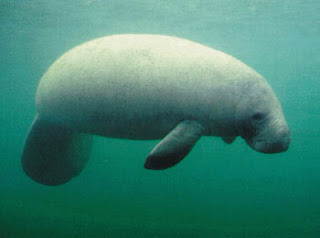 |
| It's like a floating round blob with flippers. |
The West Indian Manatee (Trichechus manatus) is a large aquatic mammal of the order Serenia. They are found in shallow coastal areas where seagrass beds or freshwater vegetation flourish. They are gentle, slow-moving animals that are completely herbivorous. The West Indian Manatee population is estimated at only about 2500.
West Indian Manatees have no natural enemies. However, a large number of manatee fatalities are from human-related activities such as ingestion of fish hooks, litter, and entanglement in nets and destruction of its natural habitat. However, the most serious threat that the manatees are facing is collision with watercraft.
A 2000 National Geographic article stated that 900 manatees had been killed by boats since 1994. Manatees cannot hear the low frequency sounds emitted by boats and thus do not know that they are in danger in order to get out of the way.
The reproduction rate for manatees is low. They are not sexually mature until they are five years old and only one calf is born every two to five years. Due to their low reproduction rate, a decline in manatee population may be hard to overcome.
They are protected under federal law by the Marine Mammal Protection Act of 1972 and the Endangered Species Act of 1973 which make it illegal to harass, hunt, capture or kill any of these marine mammals.
As a result of the Endangered Species Act, the Florida Manatee Recovery Plan was developed and is coordinated by the U.S. Fish & Wildlife Service. The plan is geared towards recovering manatees from their current endangered status. Site-specific boat speed zones were developed in 13 counties where manatee population is relatively high. This step is to reduce the likelihood of watercraft collisions.
The scientists at Florida Atlantic University have developed a high frequency warning device that is to be attached to boats to warn manatees of a boat’s presence. The Save the Manatee Club was established in 1981 and advocates legislation on behalf of manatees, and raises funds for equipment used in manatee rescue and rehabilitation efforts. Large amount of research is also being carried out to learn more about the West Indian Manatee in hopes of learning more about this aquatic mammal and finding new ways to protect and conserve it.
No comments:
Post a Comment